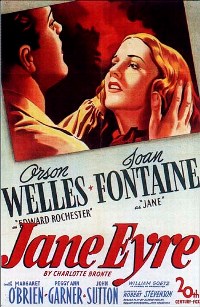
JANE EYRE
US, 1944, 90 minutes, Black and White.
Orson Welles, Joan Fontaine, Peggy Ann Garner, Margaret O' Brien, Elizabeth Taylor, Sarah Allgood, Agnes Moorehead, Hillary Brooke.
Directed by Robert Stevenson.
Jane Eyre is the 1944 version of Charlotte Bronte's tempestuous, but romantic Victorian novel. Her sister Emily's less compromisingly happy novel, Wuthering Heights, was filmed in 1939 with Laurence Olivier and Merle Oberon. Both novels show a remarkably vivid imagination on the part of these two daughters of a Yorkshire minister who lived quite a distance from the cities of Victorian England. While they are love stories with more than Victorian intensity, they also highlight something of the harshness of the times and the lonely English country.
Both novels were filmed again in 1970. Wuthering Heights was given the youth-oriented touch with Anna Calder- Marshall and Timothy Dalton as the tortured couple. Susannah York and George C. Scott re-enacted the roles of Joan Fontaine and Orson Welles. Joan Fontaine has both strength and delicacy in her performance. Orson Welles gives Rochester the grand horror touch in young Welles fashion and carries it off well.
1. Even though this is an old version of a film re-made in 1970, do you think that this version is still enjoyable and worth serious consideration?
2. Was the device of linking episodes and giving emotional comment by means of the text of the novel itself, used well? Did it add anything to the narrative?
3. The introduction to the film, quoting the first paragraph of the novel, stressed the social conditions of the times, that they were hard times of change and that religion and charity were used as cold names to cover severity. How well did the film illustrate this theme? Is it an accurate account of the times? cfr. Dickens' novels.
4. Was Jane a good girl when young? Given the treatment she received, was she good? Was the contrast with Aunt Reed and her pampered child overdone?
5. How typical were Mr. Brocklehurst's behaviour at Aunt Reed's and his subsequent long speech to Jane, as she stood on the stool, on the educational and religious values of the times?
6. How well done were the sequences at the school? What message were they intended to convey?
7. What was the role of Helen in the film?
8. How did the tone of the film change after Jane left the school? What kind of woman did she emerge as after 10 years of Mr. Brocklehurst - her interview with him, her advertising for the position, her shyness during the journey?
9. How did the atmosphere of the Rochester household contribute to the atmosphere of the film?
10. Did Orson Welles make Rochester an attractive character? Do you understand how Jane came to love him?
11. What did the character of Adele contribute to the film?
12. How melodramatic was the film with its darkness, corridors, screaming, fire, murder attempts and locked up maniacs? Did this spoil the film at all? Why?
13. Why were the Ingram party introduced into the film? What picture of society did they give? (Their humiliating talk about governesses, Blanche's snobbery.)
14. Why did Rochester grow to love Jane?
15. Should he have made the attempt to marry her?
16. Did Jane do the right thing in going? Why did she not stay with him?
17. How sorry did you feel for Rochester at this stage of the film?
18. What lessons were taught by Jane's return to Aunt Reed and Jane's discovery of her sorrows?
19. Were you glad that Mrs. Rochester burnt the house down and there was a happy ending? Why? Did you feel Rochester's blindness and recovery was overdone?